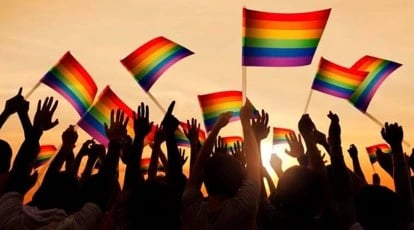

It's been almost 100 years since the first documented Society for Human Rights was founded.
In December 1924, Henry Gerber of Chicago launched the first-ever American gay-interest publication, Friendship and Freedom. It lasted two issues.
In April 1952, the American Psychiatric Association included homosexuality in its Diagnostic & Statistical Manual as a sociopathic personality disturbance.
On October 11, 1988, the first National Coming Out Day was observed and in December 1996 a Hawaii judge ruled that the state did not have a legal right to deprive same-sex couples of the right to marry, making them the first state to recognize that homosexual and heterosexual married couples are entitled to equal privileges.
In October 2009, President Obama signed the Matthew Shepard and James Byrd Jr. Hate Crimes Prevention Act into law and in a May 9, 2012 televised interview, became the first sitting US president to publicly support the freedom for LGBTQ+ couples to marry.
On February 26, 2018, the Pentagon confirmed that the first transgender person had signed a contract to join the US military. Then in October 2021, the State Department announced that the US had issued the first US passport with an X gender marker, and in October 2022, the Social Security Administration announced that people can now choose their sex marker in their Social Security records.
The world has been witness to a lot of hard-won change for LGBTQIA+ communities, especially in more recent years. You can read more history here or pretty much anywhere on the internet. Unfortunately, there is still a long road ahead and our friends, families, and peers need us to step up!
At ZVT, we're doing our part today by talking about International Day Against Homophobia, Transphobia, and Biphobia (IDAHOTB). IDAHOTB is observed annually on May 17th and aims to raise awareness of the violence and discrimination faced by LGBTQIA+ people worldwide. It was created to draw attention to the issues of homophobia, transphobia, and biphobia and to promote a world free of prejudice and discrimination based on sexual orientation, gender identity, or gender expression. Established in 2004 by Louis-Georges Tin, a French academic and LGBTQ+ rights activist to commemorate the World Health Organization's (WHO) decision in 1990 to declassify homosexuality as a mental disorder, it had grown to be celebrated in over 130 countries by 2016.
The WHOs milestone of removing homosexuality from the list of mental disorders was a significant step toward the recognition and acceptance of LGBTQIA+ rights globally, however, IDAHOTB is particularly strong in Europe and Latin America, where you can find public events in nearly every country from marches to parades and even festivals. In Sweden, even government bodies observe this day and in Chile in 2013, 50,000 people took to the streets in solidarity.
Celebrations are said to be emersed in arts and culture, so diversity goes beyond sexual orientation or gender identity while honoring one another. Also in 2013 in Bangladesh, activists organized a music festival called "Love Music Hate Homophobia." Other gatherings have included rainbow balloon releases, dance flashmob, and performance and street art. Other places such as Nepal, Canada, Montreal, Italy, Brazil, Liverpool, Mexico, and Bolivia have established similar celebrations on or around May 17.
As a result of the awareness that IDAHOTB has raised, and the solidarity it has encouraged among LGBTQIA+ communities and their allies, leaders across the globe are becoming more outspoken in support of LGBTQIA+ communities and calling for more efforts to put an end to discrimination. In 2021, US President Biden publicly shared his support of this day in his call on Congress to pass the Equality Act. Canadian Prime Minister Justin Trudeau that same day, spoke out about creating the first federal LGBTQ2 Action Plan, legislation that would into place protections for gender identity and expression.
Here's what you can do:
Participate in Local Events: Join marches, rallies, or workshops in your community.
Educate Yourself and Others: Use the day to learn more about LGBTQ+ issues and share this knowledge.
Support LGBTQ+ Organizations: Donate to or volunteer with organizations that work towards LGBTQ+ rights and support.
Amplify Voices on Social Media: Share messages of support and raise awareness using relevant hashtags.